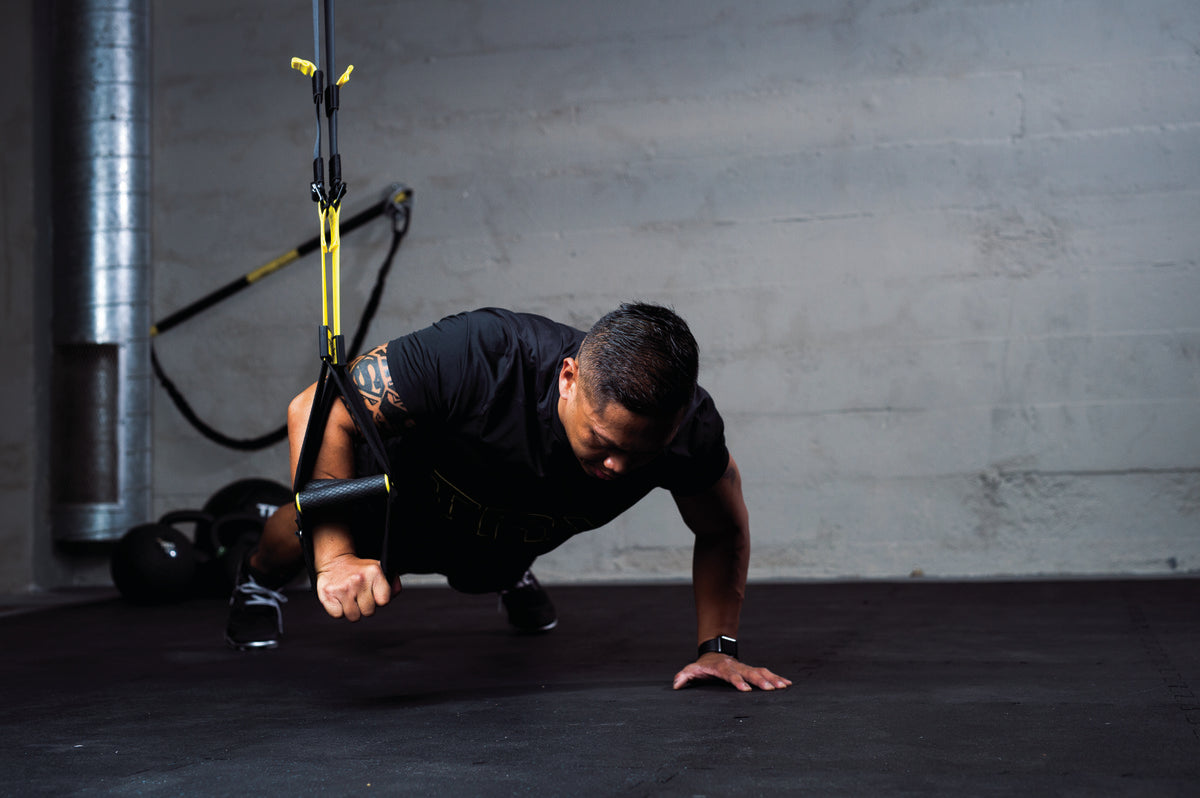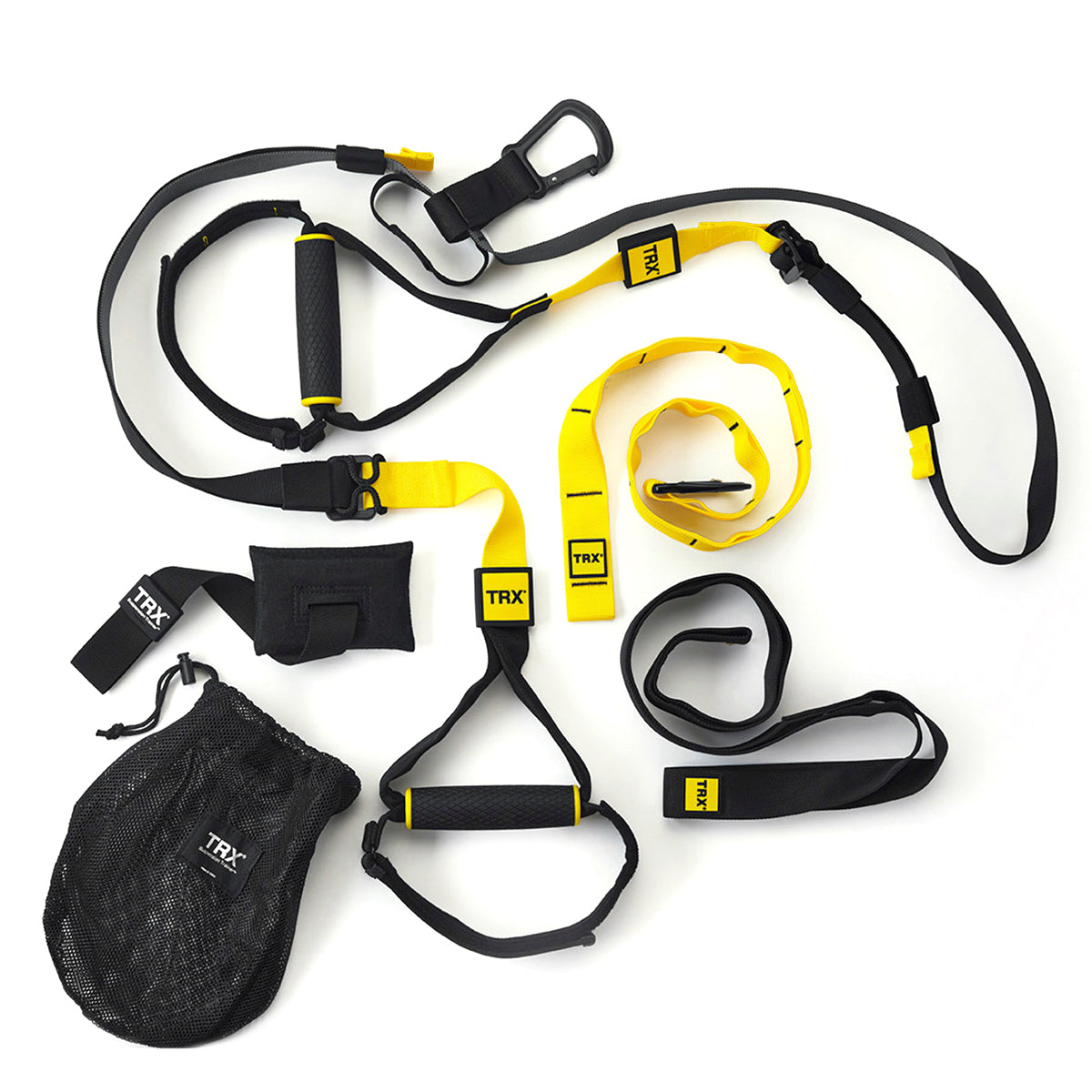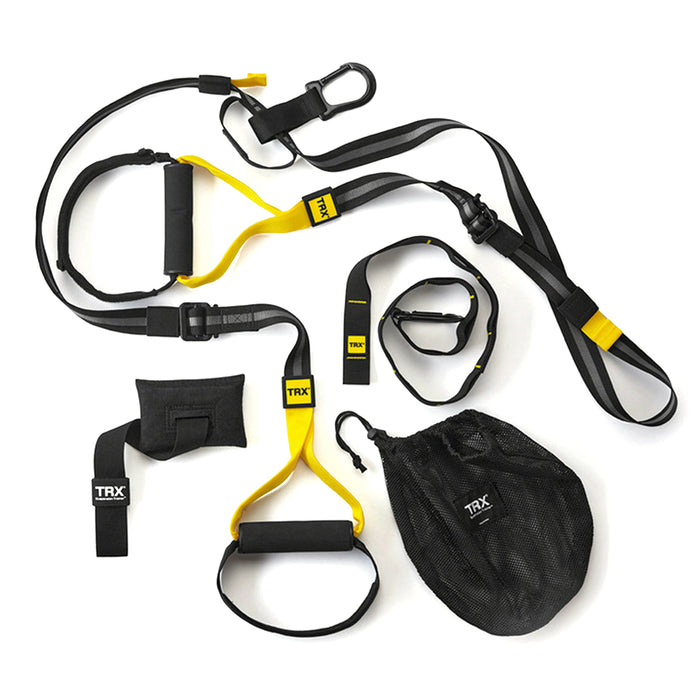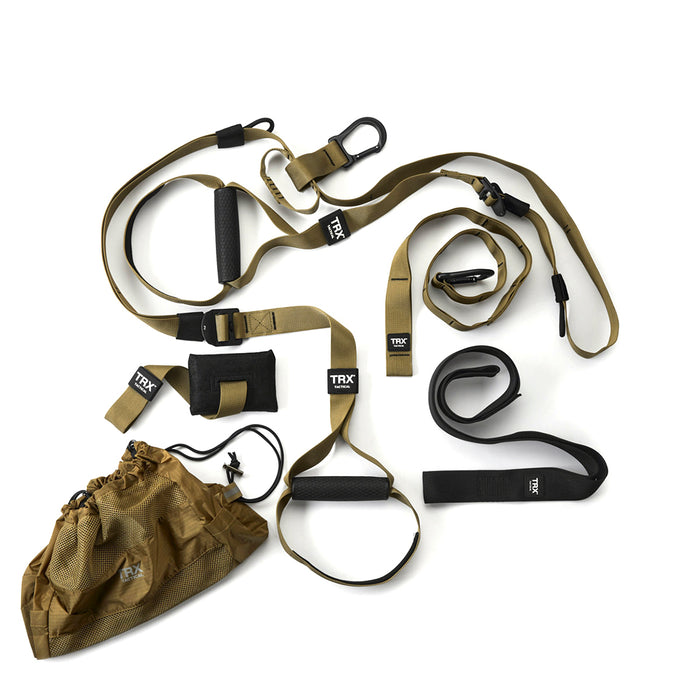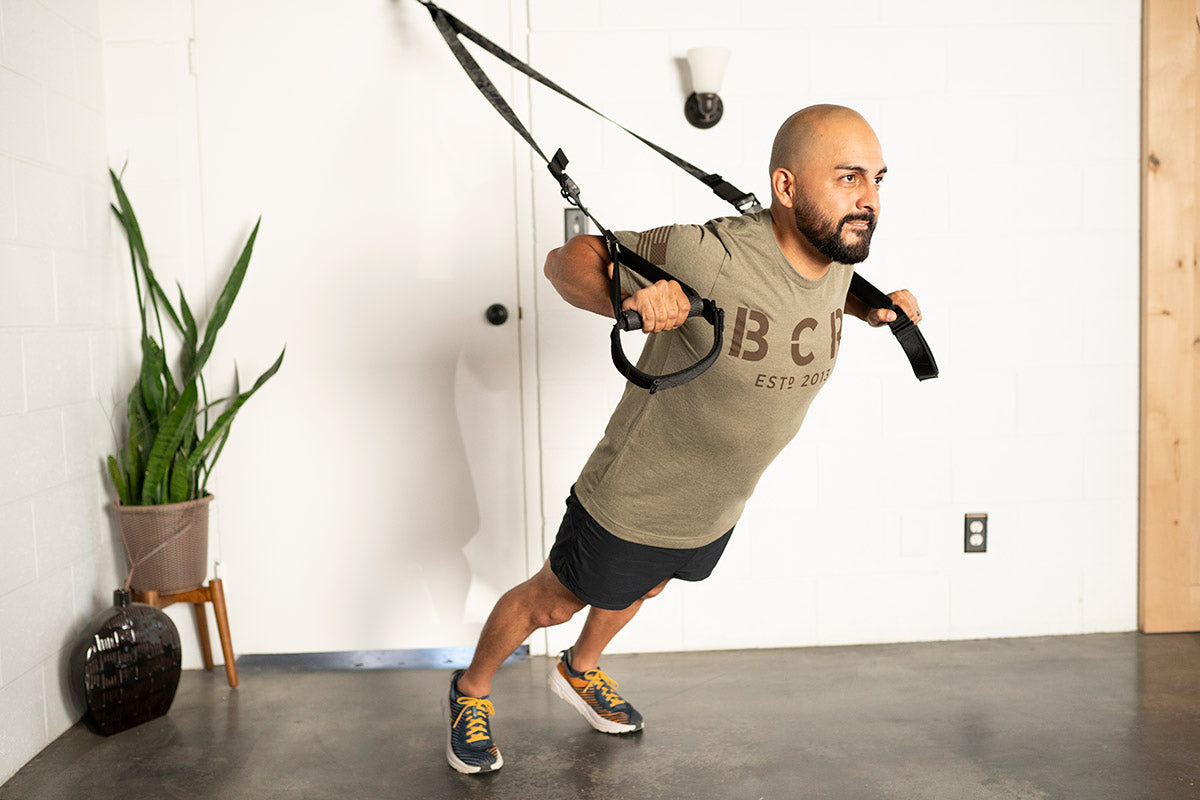The TRX pushup is a dynamic TRX exercise that can help you build your upper body at home, all while developing your core strength, stability, and balance. This exercise utilizes a TRX suspension trainer to challenge your muscles in a unique way. In this article, we will guide you through the proper technique for performing TRX push-ups, emphasizing the importance of mastering the correct form to maximize the benefits of the exercise.
In this article, you’ll find: an exploration of the crucial importance of proper form, a detailed guide on setting up the TRX suspension trainer safely, and step-by-step instructions for the basic TRX pushup technique. We’ll cover various levels of difficulty by explaining the different variations possible and share valuable tips for success. We’ll discuss how to seamlessly incorporate TRX push-ups into your workout routine and identify common mistakes to avoid.
What is a TRX Push-Up?
To truly understand how to perform a TRX pushup with precision, let's begin by defining what this exercise is and why it offers unique benefits.
A TRX pushup is a bodyweight exercise that leverages suspension straps, like those provided by the TRX, to challenge and strengthen the upper body and core. This exercise is highly effective for building muscle and enhancing functional strength. Unlike traditional push-ups, where your hands are on the ground, in a TRX pushup, you hold onto the handles of the suspension trainer while facing down toward the ground, in a standing position. Whether you're doing strength training at home or the gym, this position introduces an element of instability, demanding greater engagement of your core and stabilizer muscles.
Key Benefits of the TRX Push-Up include:
- Enhanced Core Activation: One of the standout features of the TRX push-up is its ability to intensify core engagement. As you perform the exercise, your core muscles work tirelessly to maintain stability, creating a strong and resilient core over time.
- Improved Upper Body Strength: TRX push-ups target the chest, shoulders, and triceps, allowing for comprehensive upper body strength development. The instability of the suspension straps also necessitates greater activation of these muscle groups.
- Enhanced Balance and Stability: Balancing on the suspension trainer forces you to engage your stabilizer muscles, enhancing your overall balance and stability, which is essential for various physical activities and everyday movements.
- Adjustable Intensity: TRX push-ups are adaptable to various fitness levels. Whether you're a beginner or an advanced athlete, you can adjust the difficulty level by altering your body angle and stance.
While the goal of both TRX push-ups and traditional push-ups is to strengthen the upper body, they differ significantly due to the use of suspension straps. In a traditional push-up, you're on the ground, which provides a stable surface. In contrast, the TRX pushup introduces instability, requiring additional effort to maintain proper form and balance. This instability leads to greater muscle activation, especially in the core and stabilizing muscles.
The TRX pushup's unique design allows for a more comprehensive upper-body workout, making it a valuable addition to your exercise routine. In the next section, we will guide you on how to set up your TRX suspension trainer correctly, ensuring a safe and effective workout.
Before you learn how to do a TRX push-up, you're going to need a suspension trainer:
How to Do TRX Push-Up
- Begin by setting up your TRX suspension trainer to a sturdy anchor point such as an X mount or door anchor.
- Adjust the straps to fully lengthen, do this by adjusting both straps at the same time to maintain symmetry.
- Stand facing away from the anchor point of the suspension trainer. Rest the straps on your shoulder and hold one handle in each hand with your palms facing down. Keep your wrists straight, think knuckles punching towards the floor.
- Walk your feet back toward the anchor point to create an inclined body angle, the further you walk back, the more resistance there will be, and the harder the exercise will become.
- Stand with your feet hip-width apart, heels elevated so that your weight is on the balls of your feet. Maintain a neutral spine and engage your core muscles to keep your body aligned.
- Your hands should be shoulder-width apart this is your start position
- Maintaining your plank position, lower your chest towards the handles by simultaneously bending your elbows and moving your hands apart
- Lower your body until your chest is between your hands or slightly below them. Make sure your body remains in a straight line from head to heels.
- Push yourself back up to the starting position, extending your arms while maintaining control.
It's crucial to perform TRX push-ups with controlled and deliberate movements. Avoid using momentum to swing your body, as this can reduce the effectiveness of the exercise and increase the risk of injury. Focus on maintaining proper form throughout each repetition.
As you become more comfortable with the basic TRX pushup, you can progress to more advanced variations, which we will explore in the next section. These variations can challenge your muscles in different ways and provide a more comprehensive upper body and core workout.
How to Get the Form Right for TRX Push-Up
Maintaining proper form is paramount when performing TRX push-ups. Correct form not only prevents injuries but also ensures that you're effectively targeting the intended muscle groups. In this section, we will delve into the key elements of form and provide specific tips to help you achieve it.
- Ensure your wrists are in a neutral, straight position. Avoid excessive bending or hyperextension of the wrists, which can lead to discomfort or injury.
- As you lower focus on your elbows tracking a 45-degree angle, excessive lifting or dropping of the elbows may cause the muscular emphasis to switch the shoulder joints, negating the strength focus for the chest.
- Maintain a neutral spine throughout the exercise. This means your head, neck, and back should form a straight line. Avoid dipping your head at the end of the rep!
- Engage your core muscles to prevent your hips from sagging or rising. A straight line from head to heels is essential.
- Focus on achieving a full range of motion. Lower your chest until it is between your hands. If you can’t achieve this range walk forwards away from the anchor point to reduce the resistance and thus prioritize range of motion.
- Ensure that you push yourself up to the starting position fully, extending your arms without locking your elbows.
By paying close attention to these form tips, you'll not only reduce the risk of injury but also maximize the benefits of the TRX push-up. Proper form ensures that you're effectively targeting your chest, shoulders, triceps, and core muscles while maintaining balance and stability.
How to Make the TRX Push Up More Difficult
Once you've mastered the basic TRX push-up, you may want to increase the challenge to continue your progress and develop greater strength and stability. In this section, we will explore various techniques to make the TRX push-up more difficult:
- Feet Elevation: Elevating your feet by placing them on a bench, box, or sturdy surface increases the angle of your body. This change in angle intensifies the exercise by shifting more of your body weight onto your upper body, requiring greater strength to perform each repetition.
- Single-Leg TRX Push-Up: Perform the TRX push-up with one foot off the ground. This added instability demands more core engagement and balance.
- Single-arm TRX Push-Up: This is an extremely advanced variation to incorporate instability. Taking hold of one handle only, pull the strap so it locks into place, and perform the exercise using one arm only. You’ll need to take your feet wider than shoulder width apart to create a solid base. Proceed with caution, performing slow controlled reps
- Unstable Surfaces: Try placing your feet on unstable surfaces like stability balls or Bosu balls. These surfaces increase instability, making the exercise more challenging.
- TRX Pike Push-Up: This exercise is performed on the floor from a plank position, toes in the foot cradles. Start with your hands wider than shoulder width apart, lower your body towards the floor, and lift your hips over your shoulders to create an inverted ‘V’ shape as you push up to the plank. This pike motion engages your core and shoulders more intensely.
- TRX Knee Tuck Push-Up: Following the same setup as the push-up pike, this time as you lift the hips simultaneously bend your knees towards your chest. This exercise adds an extra core and hip flexor challenge.
By incorporating these techniques, you can progressively challenge yourself as you become more experienced with the TRX push-up. Remember to maintain proper form and only progress to more difficult variations once you have a strong foundation with the basic TRX push-up. As you continue to advance, you'll build even greater upper body and core strength and enhance your overall fitness level.
How Many Reps Should You Do?
Determining the right number of reps for your TRX push-up is a crucial aspect of your training. The number of repetitions you should perform can vary greatly depending on your individual fitness level and your specific goals. In this section, we'll delve into the importance of individualization and provide general rep and set recommendations for different fitness levels.
Every person's fitness level, goals, and abilities are unique. Therefore, it's essential to tailor your rep and set counts to your specific needs. Individualization allows you to progress safely and effectively.
Beginners: If you're new to TRX push-ups or bodyweight exercises, start with 2-3 sets of 8-10 reps. This lower rep range allows you to focus on proper form and build a foundational level of strength.
Intermediate: For those with some experience, aim for 3-4 sets of 10-15 reps. This range provides a balance between building strength and muscular endurance.
Advanced: Advanced individuals can challenge themselves with 4-5 sets of 15-20 reps or more. The higher rep range focuses on muscular endurance, with the option to progress to more difficult variations. To Focus on building strength try 4-5 sets of 6-8reps as heavy as you can without compromising form.
Regardless of your fitness level, it's crucial to understand the concept of progressive overload. This means gradually increasing the demands on your muscles over time. As your body adapts to a certain rep and set scheme, you need to challenge it further to continue making progress. You can achieve progressive overload by:
- Adding reps: Increase the number of repetitions you perform in each set.
- Adding sets: Incorporate an additional set to your routine.
- Increasing difficulty: Progress to more challenging TRX push-up variations, as discussed in a previous section.
- Adding resistance: If available, consider wearing a weighted vest or backpack to increase the intensity.
Remember that rest and recovery are equally important. Listen to your body and allow sufficient time for your muscles to recuperate between TRX push-up sessions. To ensure you are making consistent progress and effectively working toward your fitness goals, periodically reassess your rep and set counts. By doing so, you can adapt your TRX push-up routine to your evolving capabilities and aspirations.
Try This Sample TRX Push Up Workout
Putting your knowledge of TRX push-ups into practice is a fantastic way to improve your strength and fitness. Before starting your TRX push-up workout, it's essential to warm up to increase blood flow, loosen your muscles, and prepare your body for exercise. Perform dynamic stretches, such as arm circles, shoulder rolls and torso twists.
Basic TRX Push-Up
Sets: 3
Reps: 10-12
Rest Interval: 60-90 seconds
Beginners: Reduce the number of sets and reps for each exercise to match your current fitness level. Walk forward (away from the anchor point) to decrease resistance
Intermediate: follow the suggested sets and reps for each exercise in the sample workout. If you find it too challenging, consider decreasing the number of reps slightly.
Advanced: To increase the difficulty, you can add an extra set to each exercise or increase the number of reps. Alternatively, slow the tempo of the eccentric phase of the exercise
TRX Pike Push-Up
Sets: 3
Reps: 8-10
Rest Interval: 60-90 seconds
Beginners: perform the push-up on your knees before lifting to the plank and then adding the pike
Intermediate: follow the suggested sets and reps for each exercise in the sample workout. If you find it too challenging, consider decreasing the number of reps slightly.
Advanced: To increase the difficulty, you can add an extra set to each exercise or increase the number of reps. Alternatively, slow the tempo of the eccentric phase of the exercise
TRX Single-Arm Push-Up (each arm)
Sets: 2
Reps: 6-8
Rest Interval: 60-90 seconds
Beginners: Create a strong base by using an offset stance of one foot in front of the other
Intermediate: follow the suggested sets and reps for each exercise in the sample workout. If you find it too challenging, consider decreasing the number of reps slightly.
Advanced: To increase the difficulty, you can add an extra set to each exercise or increase the number of reps. Alternatively, slow the tempo of the eccentric phase of the exercise
After completing your TRX push-up workout, it's crucial to cool down to help your body recover and reduce muscle soreness. Perform static stretches for major muscle groups, holding each stretch for about 30-60 seconds.
For more TRX workouts like the one above, join the TRX Training Club and get 1000s of workouts from world-class trainers, all able to be done from the comfort of your home.

Conclusion
In this article, we've explored the ins and outs of the TRX push-up, a highly effective exercise for building upper body and core strength. The TRX push-up is a dynamic bodyweight exercise that utilizes suspension straps to enhance upper body and core strength while improving balance and stability. As we conclude, it's vital to reinforce the significance of proper form when performing TRX push-ups. Proper form not only ensures your safety but also enhances the effectiveness of the exercise, enabling you to build strength and stability more efficiently.
We encourage you to incorporate TRX push-ups into your fitness routine. Whether you're a beginner or an experienced athlete, TRX push-ups can be tailored to your specific level.
So, grab those suspension straps, master the TRX push-up, and embark on a journey to a fitter, more resilient you. Your upper body and core will thank you for it!

